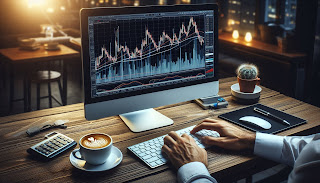Trading Coffee Futures- What Every Aspiring Trader Must Know
Coffee is more than just a beloved beverage; it is a globally traded commodity with a dynamic and fascinating market. Coffee futures, a popular derivative product, allow traders to speculate on price movements or hedge against price volatility. For aspiring traders, diving into coffee futures trading can seem daunting but offers exciting opportunities. This blog post provides a comprehensive guide to help you understand the essentials of trading coffee futures, the risks, strategies, and the market’s inner workings.
What Are Coffee Futures?
Coffee futures are standardized contracts traded on commodity exchanges, primarily the Intercontinental Exchange (ICE). These contracts obligate the buyer to purchase or the seller to deliver a specified quantity of coffee at a predetermined price on a future date. The two primary types of coffee traded in futures markets are:
- Arabica Coffee: Known for its mild flavor and higher quality, Arabica coffee is the most traded variety.
- Robusta Coffee: Known for its higher caffeine content and a more bitter taste, Robusta is often used in instant coffee and espresso blends.

Why Trade Coffee Futures?
- Global Demand: Coffee is one of the most consumed beverages worldwide, ensuring constant market activity.
- Price Volatility: Factors like weather, geopolitical events, and supply chain disruptions can lead to significant price swings, creating opportunities for traders.
- Diversification: Coffee futures offer a way to diversify investment portfolios by adding exposure to the commodities market.
- Leverage: Futures trading provides leverage, allowing traders to control larger positions with a relatively small amount of capital.
How the Coffee Futures Market Works
The Key Players
- Producers: Farmers and cooperatives use futures to hedge against price declines.
- Consumers: Coffee roasters and manufacturers hedge against rising prices.
- Speculators: Traders aim to profit from price movements without intending to take physical delivery.
Contract Specifications
- Contract Size: Typically 37,500 pounds (approximately 250 bags) for Arabica coffee.
- Tick Size: The minimum price movement is $0.0005 per pound or $18.75 per tick.
- Trading Hours: Futures markets have specific trading hours, often in alignment with major global exchanges.
Price Influencers
- Weather Conditions: Droughts or frosts in major coffee-producing regions, such as Brazil, Colombia, or Vietnam, can drastically impact prices.
- Currency Exchange Rates: As coffee is traded globally, fluctuations in currencies like the Brazilian real and U.S. dollar influence pricing.
- Supply Chain Disruptions: Shipping delays, political instability, or logistical challenges can affect supply.
- Consumer Trends: Changes in global coffee consumption patterns, such as the rise in specialty coffee, can shift demand.
Steps to Start Trading Coffee Futures
1. Understand the Market
Before trading, immerse yourself in the coffee market. Research production trends, seasonal patterns, and historical price data.
2. Choose a Brokerage
Select a brokerage firm offering access to commodity futures. Ensure the platform provides competitive fees, robust research tools, and educational resources.
3. Set Up a Trading Account
Open a margin account for futures trading. Be prepared to meet margin requirements, which are a fraction of the contract value held as collateral.
4. Develop a Trading Plan
Outline your strategy, including entry and exit points, position size, and risk management rules. A clear plan helps avoid impulsive decisions.
5. Monitor the Market
Stay updated on coffee-related news, economic indicators, and global events that might influence prices. Use charting tools to analyze price trends.
Strategies for Trading Coffee Futures
1. Trend Following
This strategy involves identifying and riding trends in coffee prices. Traders use technical indicators like moving averages and trendlines to enter and exit positions.
2. Range Trading
If coffee prices are moving within a defined range, traders can buy near support levels and sell near resistance levels.
3. Seasonal Patterns
Coffee production and demand often follow seasonal cycles. For example, prices may spike during harvest periods or before frost risks in key growing regions.
4. Hedging
Hedgers, such as coffee producers or roasters, use futures to lock in prices and mitigate the risk of adverse price movements.
5. News-Based Trading
Monitoring weather reports, crop forecasts, and geopolitical events can help traders anticipate price movements.
Risks of Trading Coffee Futures
- High Volatility: While volatility creates opportunities, it also increases the risk of significant losses.
- Leverage: Futures trading amplifies both gains and losses, making proper risk management crucial.
- Complexity: Understanding the intricacies of the coffee market, including production trends and macroeconomic factors, requires time and effort.
- Liquidity Risk: During periods of low trading activity, it may be challenging to buy or sell contracts without impacting the price.
Risk Management Tips
- Set Stop-Loss Orders: Protect your capital by defining the maximum loss you are willing to accept on a trade.
- Diversify: Avoid overexposure to a single commodity by diversifying your portfolio.
- Limit Leverage: Use leverage conservatively to avoid magnified losses.
- Continuous Learning: Stay informed about market developments and refine your strategies regularly.
Technological Tools for Coffee Futures Trading
- Charting Software: Platforms like TradingView and MetaTrader provide advanced charting capabilities.
- News Aggregators: Tools like Bloomberg or Reuters help traders stay updated on relevant news.
- Algorithmic Trading: Advanced traders can use algorithms to execute trades based on predefined criteria.
Real-Life Examples of Coffee Futures Movements
- Brazilian Frost of 1994: Severe frost damaged coffee crops in Brazil, the world’s largest producer, causing a price surge.
- COVID-19 Pandemic: Supply chain disruptions and changing consumption patterns led to unpredictable price movements in the coffee market.
Conclusion
Trading coffee futures offers an exciting avenue for aspiring traders to engage with a globally significant commodity. However, success requires a deep understanding of the market, disciplined risk management, and a well-thought-out strategy. By staying informed about price influencers and leveraging the right tools, traders can navigate the complexities of coffee futures and unlock profitable opportunities.
Whether you’re looking to hedge risks or speculate for profits, coffee futures trading is a journey worth embarking on—with the right preparation.



Comments
Post a Comment